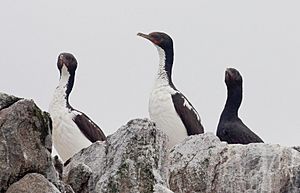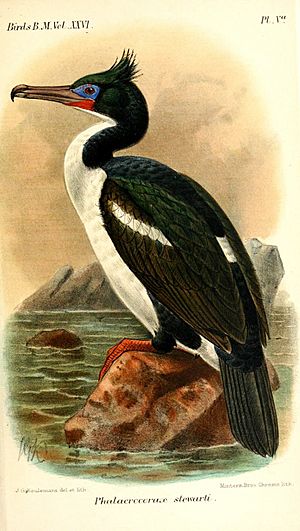Foveaux shag facts for kids
Quick facts for kids Foveaux shag |
|
|---|---|
 |
|
| Scientific classification | |
| Genus: |
Leucocarbo
|
| Species: |
stewarti
|
| Synonyms | |
|
Phalacrocorax stewarti Phalacrocorax chalconotus Leucocarbo chalconotus |
|
The Foveaux shag (Leucocarbo stewarti) is a special type of shag. It lives only around Stewart Island/Rakiura and Foveaux Strait in New Zealand. This bird is named after the Foveaux Strait.
People used to think the Foveaux shag was the same as the Otago shag. Sometimes, the Foveaux shag is called the bronze shag when it has dark feathers.
Contents
How Scientists Classify the Foveaux Shag
Until 2016, scientists grouped Foveaux shags with Otago shags. They called them both the Stewart Island shag. But then, new studies showed they are different.
Scientists looked at their DNA, bones, and how they look. They also studied their behavior. All this evidence showed that Foveaux shags are a separate species. They are now called L. stewarti. Otago shags are actually more closely related to Chatham shags.
Foveaux and Otago shags likely became separate species a long time ago. This happened when sea levels were lower, splitting their populations.
What the Foveaux Shag Looks Like
Foveaux shags are interesting because they come in two different colors. This is called being dimorphic. About half of these birds have black and white feathers. The other half are completely dark all over. Both color types can breed together.
These birds are quite large and strong. They are about 68 centimeters (27 inches) long. They weigh between 1.8 and 2.9 kilograms (4 to 6.4 pounds). They are a little smaller than Otago shags.
You can tell a Foveaux shag from an Otago shag by looking at its face. During breeding season, Foveaux shags have dark orange bumps on their face. Otago shags have these bumps too, but they also have small, bright orange growths above their beak.
Where Foveaux Shags Live and How They Are Protected
Foveaux shags only live around Stewart Island and Foveaux Strait. They have always lived there. You might rarely find a bird washed up on a beach in Otago. But they usually stay close to their home waters.
These shags build their nests in groups called colonies. They start nesting in September. They make cup-shaped nests from plants and guano (bird droppings). They build these nests on islands and sea cliffs. Their colonies are very noticeable and they use the same spots every year.
Foveaux shags find their food in coastal waters. They usually feed in water less than 30 meters (98 feet) deep. You will almost never see them far inland or far out at sea.
There are fewer than 2500 Foveaux shags left. Their population seems to be stable. This is good news, especially compared to the Otago shag, whose numbers are still going down. Foveaux shags are doing better because they nest on islands that are hard for predators to reach.
Even so, having a small population makes both species vulnerable. This means they could be at risk of disappearing. Protecting these birds needs special plans for each species. These plans must consider their history, genetic differences, and where they live.
See also
 In Spanish: Cormorán de la Stewart para niños
In Spanish: Cormorán de la Stewart para niños


